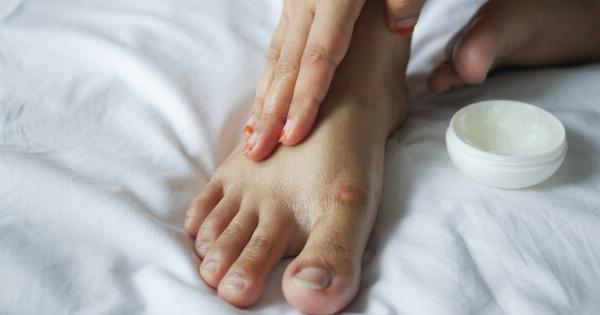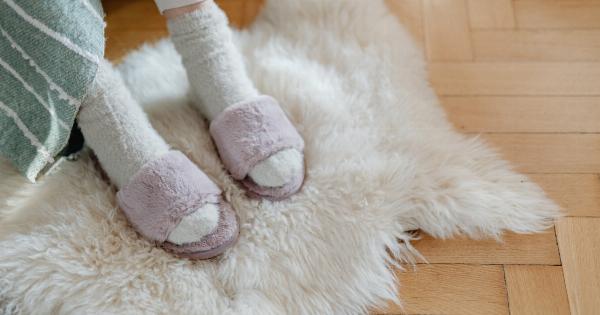Foot fungi, also known as athlete’s foot or tinea pedis, is a common fungal infection that affects the feet. It is caused by various types of fungi, including dermatophytes, yeasts, and molds.
The symptoms of foot fungi include itching, burning, redness, and flaking of the skin. If left untreated, foot fungi can spread to other parts of the body and cause further complications. However, there are simple and effective ways to keep foot fungi at bay and maintain healthy feet.
1. Practice good foot hygiene
One of the most important steps in preventing foot fungi is to practice good foot hygiene. This includes washing your feet with soap and warm water daily, especially after exercise or sweating.
Make sure to dry your feet thoroughly, including the areas between your toes, as fungi thrive in moist environments. Avoid walking barefoot in public places, such as locker rooms, swimming pools, and communal showers, as these places are breeding grounds for fungi.
2. Wear breathable footwear
Wearing breathable footwear is crucial in preventing foot fungi. Opt for shoes made of natural materials, such as leather or canvas, as they allow air circulation and help keep your feet dry.
Avoid wearing tight-fitting shoes or ones made of synthetic materials, as they can trap moisture and promote fungal growth. Additionally, rotate your shoes and allow them to air out between uses to prevent the buildup of sweat and moisture.
3. Use antifungal powders or sprays
Antifungal powders or sprays can be used as a preventive measure to keep foot fungi at bay. These products contain active ingredients, such as miconazole or clotrimazole, which help kill or inhibit the growth of fungi.
Apply the powder or spray to your feet and inside your shoes daily, especially if you are prone to sweating or have had a previous fungal infection.
4. Keep your toenails trimmed
Proper toenail care is essential in preventing foot fungi. Trim your toenails regularly, keeping them short and straight across.
Avoid cutting them too short or rounding the edges, as this can create small cuts or tears that make it easier for fungi to enter the skin. Be cautious when getting a pedicure and ensure that the tools used are properly sterilized to avoid fungal infections.
5. Wear moisture-wicking socks
Moisture-wicking socks help keep your feet dry by wicking away sweat and moisture. Choose socks made of natural fibers like cotton or bamboo, as they are more breathable and absorbent.
Avoid wearing socks made of synthetic materials, as they can trap moisture and promote fungal growth. Change your socks daily, or more frequently if you have been sweating excessively.
6. Avoid sharing personal items
Avoid sharing personal items, such as towels, socks, shoes, or nail clippers, with others to prevent the spread of foot fungi. Fungi can easily transfer from one person to another through contaminated items.
If someone in your household has a fungal infection, make sure they are using separate towels and changing their socks and shoes regularly to minimize the risk of spreading the infection.
7. Use a barrier between your feet and public surfaces
When walking in public areas where foot fungi may be present, such as public showers or changing rooms, use a barrier between your feet and the surfaces.
This can include wearing flip-flops or shower shoes to protect your feet from coming into direct contact with potentially contaminated surfaces. By creating a physical barrier, you reduce the risk of fungal infection.
8. Choose breathable footwear for physical activities
If you engage in physical activities that cause your feet to sweat excessively, such as running or playing sports, it’s important to choose breathable footwear specifically designed for these activities.
Look for athletic shoes with breathable mesh panels or moisture-wicking properties to help keep your feet dry and prevent fungal growth.
9. Disinfect your shoes
Regularly disinfecting your shoes can help kill any existing fungi and prevent reinfection. There are several ways to disinfect your shoes, including using antifungal sprays, powders, or ultraviolet (UV) shoe sanitizers.
Follow the instructions provided with the chosen disinfectant method to ensure effective treatment. Additionally, consider using disposable shoe inserts or foot powders to minimize contact between your feet and the inside of your shoes.
10. Seek prompt treatment if you suspect an infection
If you notice any symptoms of foot fungi, such as persistent itching, redness, or flaking of the skin, it is essential to seek prompt treatment. Over-the-counter antifungal creams or powders can help treat mild cases of foot fungi.
However, if the infection does not improve within a few weeks or if it becomes severe, consult a healthcare professional for further evaluation and potentially a prescription-strength antifungal medication.































